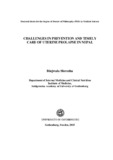Please use this identifier to cite or link to this item:
http://archive.nnl.gov.np:8080/handle/123456789/406| Title: | Challenges in prevention and timely care of uterine prolapse in Nepal |
| Authors: | Shrestha, Binjwala |
| Keywords: | Uterine prolapse - Nepal Health seeking practice Quality of life Health demographic surveillance site |
| Issue Date: | 16-Jan-2018 |
| Abstract: | Uterine prolapse is a common reproductive health problem in low-income countries like Nepal. Physical symptoms of this condition influence women’s quality of life. Current data insufficiently determine women’s awareness of this condition. Health care seeking practices for uterine prolapse in Nepal are inadequate. This Thesis aimed to assess women’s knowledge of uterine prolapse and its associated factors, explore how this affects quality of life, and describe health care seeking practices. We also aimed to determine the prevalence of UP in both rural and peri-urban settings of Nepal. This Thesis used cross-sectional descriptive studies. The mixedmethod approach included quantitative interviews with 115 respondents and qualitative in-depth interviews with 16 UP-affected women in rural Nepal. Nationally, we conducted structured interviews with 4,693 married women aged 15–49 years in 25 districts that represent all 5 administrative regions and 3 ecological zones of Nepal. To assess how uterine prolapse affects quality of life, we conducted structured interviews with 3,124 women during a household survey in the peri-urban Jhaukhel-Duwakot Health Demographic Surveillance Site outside Kathmandu and also with 48 attendees at a screening camp for uterine prolapse. A community-based case control study traced selfreported cases identified by a previous household survey and in a control group (women not having uterine prolapse) from the screening camp. Most participants (>85%) described major physical discomforts, including difficulty with walking, standing, working, sitting, and lifting. Compared to stage I, women with Stage III uterine prolapse suffered adverse effects on quality of life. They endured humiliation, harassment, torture, and severe emotional stress from their husbands and other family members due to their inability to perform household chores or fulfill their husband’s sexual desires. The prevalence of uterine prolapse in our peri-urban setting was 2.11%, where more than 53% of our participants had comprehensive knowledge of uterine prolapse (compared to only 37% in a national survey). Contributing factors included parity, education, and family structure. Knowledge gaps in the national survey associated with geography, age group, education, caste/ethnic group, and media exposure. Possible factors that influenced women’s health care seeking practices for uterine prolapse included access barriers, low socioeconomic status, gender inequality, a culture of silence, lack of autonomy for health care, and lack of regular community-based services. Major challenges for the prevention and timely care of uterine prolapse include knowledge gaps and associated factors such as geography, caste/ethnic group, education, and media exposure. Key barriers include socioeconomic status, gender inequalities, and women’s knowledge and perception regarding accessibility to quality health services. |
| Description: | Doctoral thesis for the degree of Doctor of Philosophy (PhD) in Medical Science, Department of Internal Medicine and Clinical Nutrition, Institute of Medicine, Sahlgrenska Academy at University of Gothenburg, Gothenburg, Sweden, 2015. |
| URI: | http://103.69.125.248:8080/xmlui/handle/123456789/406 |
| Appears in Collections: | 600 Technology (Applied sciences) |
Files in This Item:
| File | Description | Size | Format | |
|---|---|---|---|---|
| Final Thesis Binjwala.pdf | 599.14 kB | Adobe PDF |  View/Open |
Items in DSpace are protected by copyright, with all rights reserved, unless otherwise indicated.